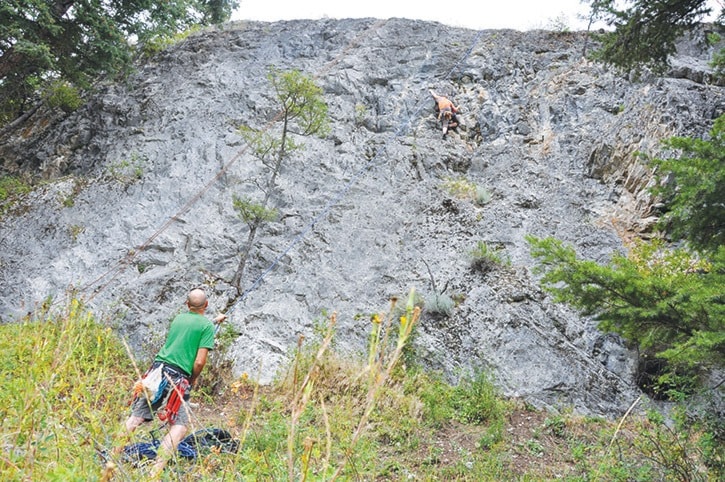Clinging to a wilderness rock cliff with fingers, toes, knees and elbows, and body-stretched to capacity is the best day ever, according to rock climbing enthusiasts Kirsten Stark and Colin Noll.
The couple, who have lived in the Cariboo for eight years, met rock climbing in Thailand.
“I was climbing before I could walk,” said Stark, who grew up in northwest England. “We had all of Cambria, the Peak District, Lanchester and North Wales, where we went on holidays. My dad’s holiday wish was always to go climbing at least once.”
Noll, who is from Toronto, got his start in a climbing gym, and has since done a significant amount of wilderness climbing in places like Asia.
They’ve now been climbing in the Williams Lake area for eight years.
“One of the reasons we moved to Williams Lake is that we have two awesome playgrounds on our doorstep,” Stark said. “We found the two places we climb in a guidebook about the area.
“The rock outcrop on Moon Road is where us crag rats hang out,” Stark said. “That’s what they call us in England.”
The type of climbing they do on Moon Road is sports climbing, where bolts and anchors are placed in the rocks ahead of time and you hook on to them.
“Traditional climbing is where you take all your own gear and equipment with you and place the bolts where you need them,” she explained. “That’s what I did growing up. I learned sports climbing later.”
Stark was about 12 years old when she did a first solo climb with no rope, on a wall twice as high as the one on Moon Road.
“Climbing is one of the most physically and mentally demanding things I’ve ever done; it may not be that hard to climb something but you can get really freaked out if you’re in a bad spot and think you’re going to fall,” Noll said.
“You’ve got some routes with 20 or 30 feet between bolts and you could fall; you could fall 40 or 60 feet.
“If you’re bolted and you’re up 20 feet and fall, you fall another 20 past the bolt before you stop. You won’t die, but it’ll hurt. I’m also afraid of heights, so that doesn’t really help.
“I love it — I just don’t look down.”
Stark was a competitive gymnast when she was young, and said there are comparisons between gymnastics and climbing.
“Core strength, it’s all on you, and it’s 90 per cent in your head,” she explained.
“At one point I was about 40 pounds overweight and decided I should really do something. I wasn’t going to go to the gym or run on a treadmill, so I started hauling myself up indoor rock walls for strength training and to burn fat.
“Wherever I was working in the UK I’d haul my boots and chalk bag around with me. There were climbing walls everywhere. You could put the word out online and pick up a climbing partner for the weekend. Climbing with different partners with different climbing styles and preferences really stretches your boundaries as to what you think you can do. You push yourself harder.”
The differences between climbing walls and outdoor climbing are significant, according to Noll.
“You can think you’re pretty good because you’ve been climbing indoors for six months. Then you go into some rock face and you can’t get three feet off the ground. Rock is not like plastic, or painted, sanded walls. It’s very different.”
He said he finds climbers a little more adventurous with a slightly different way of looking at the world.
“Rock climbing makes you focus on where you are this very moment. You’re not thinking 100 feet later, you’re thinking where you are right now,” he said.
“That’s what’s important.”
